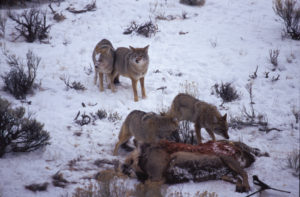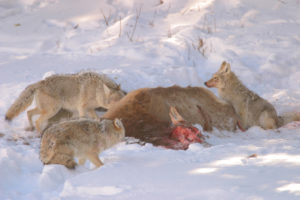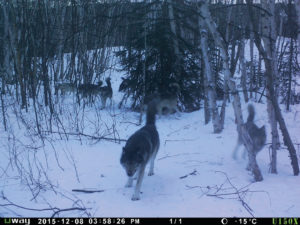You might think baiting coyotes is as easy as throwing meat scraps on the ground. You’d be wrong. (Photo: Jack Spencer Jr.)
I figured I had seen it all while hunting coyotes. But on the shortest day of the year when 21 coyotes made an appearance to my bait stand just before dusk, I knew that wasn’t the case. I somehow managed to contain myself well enough to not fire a single shot, knowing these Northern Alberta coyotes were currently fetching $175 a piece at the fur sales.
I was witnessing a coyote utopia, however. I was after the ever-moving wolves, so coyotes were nothing else to me than eye candy and something to occupy my time with while patiently waiting for the elusive wolf to make an appearance. This was no doubt one seriously effective canine bait stand!
Baiting coyotes and wolves seems like an easy endeavor by merely finding enough meat mass and placing it on the ground, sitting back and easily shooting approaching hungry canines. To an extent, this may work for the novice. However, effective baiting folks experience a considerable amount of planning, labor or difficulty if done correctly.
I would like to think I have personally run some successful canine bait stands over the years. I know I have sat in some canine bait stands that were world class, second to none. There is quite a difference in the degree of baiting perfection required to better enable a predator hunter to be constantly successful.
Background On Baiting
Baiting is basically enticing, tempting or captivating a predatory species to a certain location with food. There is so much more that goes into baiting than just a bait pile in the woods. The sights and smells an attractive bait pile emits can magnetize predators if done correctly.
There has always been a lot of controversy around baiting not only from the left-sided, emotional, anti-hunting movement, but from the very people who care the most about wildlife — hunters. I have personally seen the hunting community get into some awful arguments about how baiting is not hunting, it is unethical and should be banned. When I hear other hunters complain about baiting, I find it hard to lean towards the anti-bait side for a host of reasons, mainly because some of their very own weaponry could be considered cheating or unethical compared to what early native Americans once used to collect predators.
Most predator hunters today use accurate high-powered rifles, fine-tuned hand calls, electronic calls, range finders, expensive scopes, pop-up blinds, night vision, accurate bullets, suppressors, semi-autos, specialized clothing, footwear, use-all terrain vehicles or read Jack Spencer Jr. predator hunting articles — all of which help collect canines. There are also other types of canine collectors who set snares and traps to tie up predators until their arrival. So who's right, who's wrong and who cares?

Effective bait sites refreshed regularly may attract coyotes or wolves, depending on your location, and offer good hunting opportunities. (Photo: Jack Spencer Jr.)
Why Bait?
Last summer I voice howled a coyote within 10 yards and shot the yapping territorial male with my recurve bow. That's about the simplest technology available to kill a coyote and 99 percent of hunters will use more advanced hunting technology. I could be one of those predator hunting snobs who says if you use more gear than what I used on that 100-degree day then that could be considered cheating or unethical.
I do not consider myself a predator snob, I realize predator populations across this great land are soaring, expanding ranges and hunters, trappers, hounds man and even them lip ripping, barb snagging fisherman are all on the same team and must be team players to keep our outdoor traditions intact for future generations.
Every predator hunter has hunting preferences and goals. If you're a predator hunter that decides to incorporate baiting into your predator arsenal, then make sure you follow some sort of plan and common sense practices to be effective and keep yourself out of trouble. Predator hunting over bait comes with great responsibility.
The first thing prior to baiting canines is to make sure the state or province allows it. Every state in the United States and bordering countries have laws on what is considered legal baiting. I have read a lot of game regulations in just about every state and neighboring countries, so I admit that even as a seasoned wildlife biologist I have a hard time understanding the often easily confusing game hunting regulations.
I suggest you read and re-read the hunting regulations. If there is any questions or uncertainty on baiting then send an email to the local warden. I have learned there is a lot of interpretation by wardens in game regulations and I have sent a baiting question email to three different wardens and unsurprisingly received three different answers. When you're comfortable and familiar with your local game regulations, you have half the baiting battle over with.
How To Bait
When picking a blind location near where I am actually going to place the bait, I think about a lot of different things. I look to see where the wind usually blows because most canines are going to come downwind for their final approach to the bait. I like to have my blind positioned off to one side of where I think predators are going to come in from.
If there are a lot of raven or magpies on the bait and if canines have been pre-baited to the bait site for a long period, coyotes might throw caution to the wind and just walk on in regardless of wind direction. But it's rare. Coyotes and wolves trust the highly intelligent raven, and they provided not only a calming comfort, but help one another secure food items. “What the coyote/wolf can't smell, the raven can see.” I have seen where canines and even bears will walk for straight in for miles to investigate a murder of ravens squawking and fighting. The raven feeding sounds of this magnitude can only mean one thing — an easy meal.
I like to place my blind for coyotes 50 to 75 yards out (even closer if I am using a bow or crossbow) and 150 to 175 yards out for wolves. I can't stress enough here that you have to give wolves a lot more room than coyotes. The chances to see more than one coyote at the bait site is great, so being in tight allows for a better possibility of several coyotes harvested. I like the farther distance for the wolves because wolves are a lot wearier around the baits and really check things out before committing to the bait. Multiple wolves at the bait, at the exact same time, is rare and just the opportunity to harvest a single wolf is a spectacular feat.
I also pay particular attention to how I am going to approach my blind. Often times predators have been conditioned to be real close to the bait, so I try to find a spot where I can slip in undetected. Blinds near tree lines or some other type of taller vegetation to hide your approaching silhouette is the most desired. Many times I have approached my blind and observed predators present and actively feeding. I want to pay close attention to where I walk into my blind, because the path of travel will have my scent regardless of what scent spray I use. If there is snow on the ground, one may bait for awhile then come back and see where all the trails are coming from to better select blind locations.
Once I find my "blind spot" I set my blind up and leave it there for a few days to let it "season" so canines can have time to acclimate themselves to anything foreign. I may have to re-bait several times to keep the bait site active. I don't personally build permanent blinds over baits, however my Canadian wolf baiting friend Kyler Knelsen does, and his blinds were first class with warmth, comfort, shooting windows and best of all he done all the hard pre baiting work. I experienced a world-class bait stand with dozens of predators showing up daily. Regardless of the permanent or pop-up blinds used, it must be comfortable. Small heaters and a comfortable chair are also essential for comfort.
Bait blinds allow the predator shooter to have multiple advantages including being in control of most shot distances and having time to make a comfortable and solid rest for shots. I often pull my rifle out several times during the day and point at the bait to make sure I can do so with utmost ease and stealth to not be detected. This practice scenario also helps me settle my nerves a bit, especially when taking that rare shot at a wolf. Bait sites are terrific for first-time predator hunters because hunters should have ample amounts of time for the perfect shot.

Having the right location for the bait is one thing that makes it effective. (Photo: Jack Spencer Jr.)
Where To Bait
Baits, regardless of location, are hard to keep quiet from any predatory wildlife. I almost exclusively use private lands when placing bait piles because in my area I may have 100 ravens show up on the bait. The whole area is a feeding frenzy, and private land keeps other hunters away from my chaos.
Placing baits where others can access seems to invite trouble. I average around 300 to 600 pounds of meat scraps per bait pile and depending on the number of predators visiting my baits, I often add additional fresh bait every week. I find this re-baiting scenario common especially when I have 20 to 30 coyotes hitting a bait pile and I have seen the same amount of re-bait required when half a dozen wolves are hitting a bait pile.
Scavenging birds will take a fair share of the bait, which is just common acceptance. Big baits have big predator-pulling power. Research shows coyotes can travel up to seven miles in a day to a food site and wolves up to 25 miles to a single feeding source.
Leftover deer carcasses and road kill are excellent canine baits, though many states do not allow for the use of wildlife parts. That is why I prefer meat scraps from carcasses of livestock. Local butchers usually have a steady stream of meat scraps and you may even save meat processors money.
I use to place whole animal carcasses out, but I quickly learned that a dominate alpha male coyote or wolf can literally stand guard on the carcass and fend off any other canine competition. The small meat scraps better allow for others to sneak in and take the small pieces and spread them hundreds of yards away, actually making the bait site much larger and more inviting for predators.
Wolves more so than coyotes like to approach the bait, grab a piece of meat and quickly reside to the nearest thick brush especially during the daytime hours. You will cycle through the bait, especially with everything out there packing it off constantly, but it makes for a more effective bait site.
Last fall I sat nine days straight waiting for a wolf to make an appearance on various bait sites, but one never showed. My other hunting companions experienced a totally different hunt seeing and shooting wolves, some on the very bait I sat on the day prior. It happens. Though I didn't harvest a wolf on this northern Canada trip, I did have a great time watching "waves" of coyotes come and go from the baits all day long.
Another interesting detail when selectively baiting coyotes is you can bait coyotes to a specific location with masses of fruits and vegetables. Coyotes will readily consume these non-meat products as another highly desirable food source.
Predator hunting over well-placed bait stands can be super exciting, not only from a hunting aspect. It's truly a unique scenario to coach a whole bunch of mammalian and avian predators into a very small area and often at the same time. Properly placed bait stands can and will provide a gravitational pull attracting predators for miles around, and it's one of the easiest methods to clean out an area for coyotes. Wolves, however, is a little tougher ordeal.
Hunting predatory wildlife over effective baits stands can be exhilarating and a highly effective method to collect a good number of canines that might not otherwise come to calls and perhaps the only other practical method to collect a heap of prime winter pelts.
More top picks from Predator Xtreme:
How to scout in summer for coyotes
3 tips to hunt coyotes the simplest way possible
Coyote 101: Understanding how songdogs rear pups
Wild hogs: A must-hunt species







